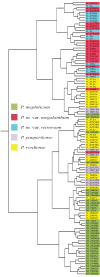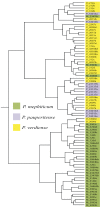Species delimitation and recognition in the Pediomelummegalanthum complex (Fabaceae) via multivariate morphometrics
- PMID: 25698894
- PMCID: PMC4329391
- DOI: 10.3897/phytokeys.44.8750
Species delimitation and recognition in the Pediomelummegalanthum complex (Fabaceae) via multivariate morphometrics
Abstract
Pediomelum is a genus endemic to North America comprising about 26 species, including the megalanthum complex, which consists of Pediomelummegalanthum and its varieties retrorsum and megalanthum, Pediomelummephiticum, and the recently described Pediomelumverdiense and Pediomelumpauperitense. Historically, species of the megalanthum complex have been variably recognized at the species or variety levels, dependent upon the relative importance of morphological characters as diagnostic of species. Ten quantitative morphological characters regarded as diagnostic at the species level were analyzed using multivariate morphometrics across these taxa in order to examine the discriminatory power of these characters to delineate species and to aid in species delimitation. The analyses support the recognition of Pediomelummegalanthum, Pediomelummephiticum, and Pediomelumverdiense at the species level, Pediomelumretrorsum as a variety under Pediomelummegalanthum, and suggest the sinking of Pediomelumpauperitense into Pediomelumverdiense. The findings of the present study help quantify the power of certain characters at delimiting taxa and provide a basis for taxonomic revision of the Pediomelummegalanthum complex.
Keywords: Fabaceae; Pediomelum; cluster analysis; multivariate morphometrics; principal component analysis; species delimitation.
Figures






Similar articles
-
Exploring the Udoteaceae diversity (Bryopsidales, Chlorophyta) in the Caribbean region based on molecular and morphological data.Mol Phylogenet Evol. 2018 Oct;127:758-769. doi: 10.1016/j.ympev.2018.06.023. Epub 2018 Jun 18. Mol Phylogenet Evol. 2018. PMID: 29913312
-
Integrating multilocus DNA data and 3D geometric morphometrics to elucidate species boundaries in the case of Pyrenaearia (Pulmonata: Hygromiidae).Mol Phylogenet Evol. 2019 Mar;132:194-206. doi: 10.1016/j.ympev.2018.12.007. Epub 2018 Dec 11. Mol Phylogenet Evol. 2019. PMID: 30550961
-
Limitations of Species Delimitation Based on Phylogenetic Analyses: A Case Study in the Hypogymnia hypotrypa Group (Parmeliaceae, Ascomycota).PLoS One. 2016 Nov 9;11(11):e0163664. doi: 10.1371/journal.pone.0163664. eCollection 2016. PLoS One. 2016. PMID: 27828951 Free PMC article.
-
Cryptic Species or Inadequate Taxonomy? Implementation of 2D Geometric Morphometrics Based on Integumental Organs as Landmarks for Delimitation and Description of Copepod Taxa.Syst Biol. 2016 Mar;65(2):304-27. doi: 10.1093/sysbio/syv088. Epub 2015 Nov 24. Syst Biol. 2016. PMID: 26608965
-
Species delimitation: inferring gaps in morphology across geography.Syst Biol. 2012 Mar;61(2):179-94. doi: 10.1093/sysbio/syr084. Epub 2011 Aug 16. Syst Biol. 2012. PMID: 21840841
Cited by
-
Taxonomic status of Rhabdochona ictaluri (Nematoda: Rhabdochonidae) based on molecular and morphological evidence.Parasitol Res. 2019 Feb;118(2):441-452. doi: 10.1007/s00436-018-6189-8. Epub 2019 Jan 10. Parasitol Res. 2019. PMID: 30631928
References
-
- Anderson E. (1949) Introgressive Hybridization. John Wiley & Sons, New York.
-
- Barneby RC. (1943) Miscellaneous diagnoses. Leaflets of Western Botany 3: 193–194 http://www.darwinproject.ac.uk/entry-1740 [accessed 25 Sept.2014]
-
- Davis PH, Heywood V. (1963) Principles of Angiosperm Taxonomy. D. van Nostrand Co., Princeton (NJ).
-
- Egan AN, Crandall KA. (2008a) Divergence and diversification in North American Psoraleeae (Fabaceae) due to climate change. BMC Biol 6: . doi: 10.1186/1741-7007-6-55 - DOI - PMC - PubMed
-
- Egan AN, Crandall KA. (2008b) Incorporating gaps as phylogenetic characters across eight DNA regions: ramifications for North American Psoraleeae (Leguminosae). Mol Phylogenet Evol 46: 532–546. doi: 10.1016/j.ympev.2007.10.006 - DOI - PubMed
LinkOut - more resources
Full Text Sources
Other Literature Sources
